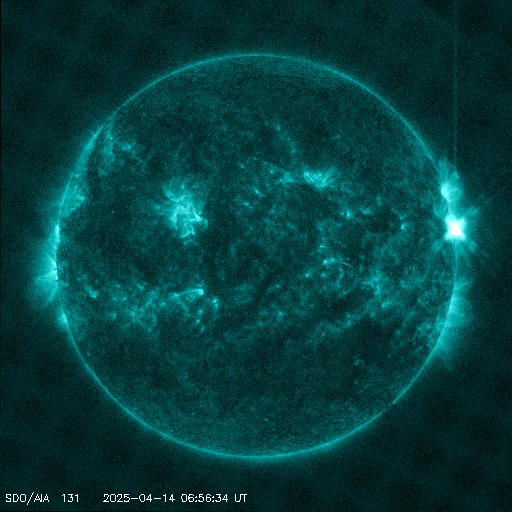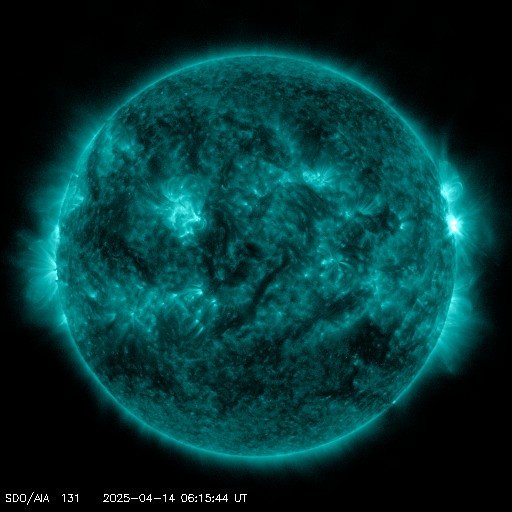Viewing archive of Saturday, 10 June 2023
Daily bulletin on solar and geomagnetic activity from the SIDC
Issued: 2023 Jun 10 1231 UTC
SIDC Forecast
Solar flares
Quiet conditions (<50% probability of C-class flares)
Geomagnetism
Quiet (A<20 and K<4)
Solar protons
Quiet
| 10cm flux | Ap | |
|---|---|---|
| 10 Jun 2023 | 164 | 010 |
| 11 Jun 2023 | 162 | 008 |
| 12 Jun 2023 | 160 | 008 |
Solar Active Regions and flaring
The solar flaring activity was at moderate levels, with one M-class flare and several C-class flares being detected in the last 24 hours. The largest flare was a M2.5 flare, peaking at 17:11 UTC on June 09, associated with NOAA AR 3331 (beta class). NOAA AR 3327 (beta-gamma) is the most complex active region on the disk but produced only C-class flares. Isolated C-class flaring was also produced by NOAA AR 3321 (alpha class) and by NOAA AR 3323 (beta class). Other regions on the disc have simple configuration of their photospheric magnetic field (alpha and beta) and did not show any significant flaring activity. The solar flaring activity is expected to be at low to moderate levels over the next 24 hours with a small chance for isolated X-class flare.
Coronal mass ejections
In the past 24 hours, several coronal mass ejections (CME) and flows were observed in the available SOHO/LASCO coronagraph imagery and automatically detected by the Cactus tool over. In particular, a CME was observed in SOHO/LASCO-C2 at around 17:24 UTC on June 09, likely related to the M2.5 flare from NOAA AR 3331. The CME is directed to the south-east and the bulk of the CME is not expected to be Earth directed. However, a glancing blow at Earth may be possible. Full analysis is still ongoing, and more details will be provided later. During the last 24 hours there were no other potentially Earth-directed CMEs detected in the available coronagraph observations.
Solar wind
Over the past 24 hours, the solar wind speed has remained in the slow solar wind regime with values between 280 km/s and 320 km/s. The interplanetary magnetic field magnitude was below 6 nT. The southward component of the interplanetary magnetic field fluctuated between -5 nT and 5 nT. Slow solar wind conditions are expected to prevail during the next days, with a probability of a weak enhancement on June 10-11, if solar wind from a coronal hole in the northern hemisphere arrives to the Earth. However, since the coronal hole is located at high latitudes, the corresponding high speed stream may miss the Earth.
Geomagnetism
The geomagnetic conditions over the past 24 hours were quiet. Mostly quiet geomagnetic conditions are expected, with chances of active and minor storm levels on June 10-11 if the high speed stream from the positive polarity coronal hole in the northern hemisphere arrives.
Proton flux levels
Over the past 24 hours the greater than 10 MeV GOES proton flux was at nominal levels and is expected to remain so over the next days.
Electron fluxes at geostationary orbit
The greater than 2 MeV electron flux was below the 1000 pfu threshold and is expected to remain below this threshold for the next days.The 24h electron fluence was at normal level. The electron fluence is expected to be at normal levels in the next days.
Today's estimated international sunspot number (ISN): 142, based on 17 stations.Solar indices for 09 Jun 2023
| Wolf number Catania | 186 |
| 10cm solar flux | 164 |
| AK Chambon La Forêt | 008 |
| AK Wingst | 004 |
| Estimated Ap | 004 |
| Estimated international sunspot number | 164 - Based on 28 stations |
Noticeable events summary
| Day | Begin | Max | End | Loc | Strength | OP | 10cm | Catania/NOAA | Radio burst types |
|---|---|---|---|---|---|---|---|---|---|
| 09 | 1648 | 1711 | 1725 | ---- | M2.5 | 25/3331 | II/1I/1 |
Provided by the Solar Influences Data analysis Center© - SIDC - Processed by SpaceWeatherLive
All times in UTC
Current data suggests there is a slight possibility for aurora to appear at the following high latitude regions in the near future
Gillam, MB, Whitehorse, YT, Yellowknife, NTAnchorage, AK, Fairbanks, AK, Juneau, AK
Latest news
Latest forum messages
Support SpaceWeatherLive.com!
A lot of people come to SpaceWeatherLive to follow the Sun's activity or if there is aurora to be seen, but with more traffic comes higher server costs. Consider a donation if you enjoy SpaceWeatherLive so we can keep the website online!

Latest alerts
07:09 UTC - Solar flare
Moderate M4.28 flare from sunspot region 4055
06:48 UTC - Radio Blackout
Minor R1 radio blackout in progress (≥M1 - current: M1.53)
06:24 UTC - Solar flare
Moderate M1.49 flare from sunspot region 4055
06:06 UTC - Radio Blackout
Minor R1 radio blackout in progress (≥M1 - current: M1.16)
04:45 UTC - Geomagnetic activity
Active geomagnetic conditions (Kp4) Threshold Reached: 04:29 UTC
Space weather facts
| Last X-flare | 2025/03/28 | X1.1 |
| Last M-flare | 2025/04/14 | M1.4 |
| Last geomagnetic storm | 2025/04/06 | Kp5 (G1) |
| Spotless days | |
|---|---|
| Last spotless day | 2022/06/08 |
| Monthly mean Sunspot Number | |
|---|---|
| March 2025 | 134.2 -20.4 |
| April 2025 | 132.1 -2.1 |
| Last 30 days | 132.4 -10.7 |





